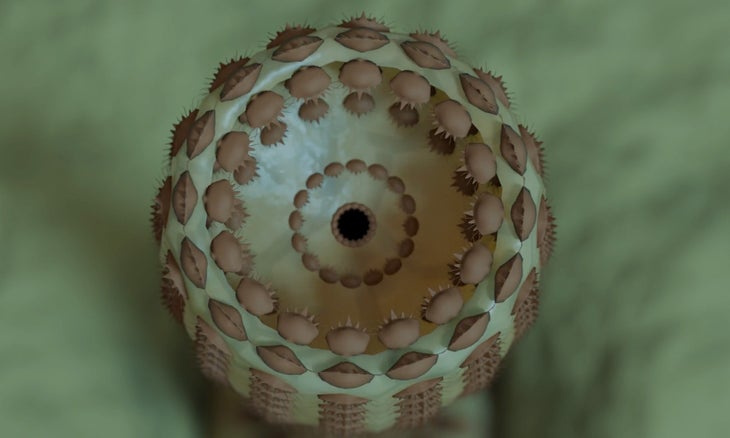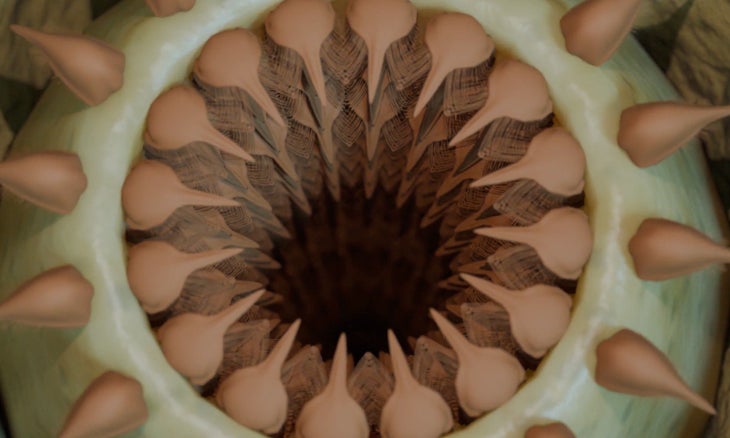The extinct creature was eight-inches long, had razor-sharp teeth, and resembled a character from the ‘Alien’ movies
Penis Worms were found in the Bright Angel Formation in the Grand Canyon (Photo: ROBYN BECK/AFP via Getty Images)
Updated August 11, 2025 12:59PM
Scientists researching the Grand Canyon recently found fossils of a never-before-seen species of the so-called penis worm, an animal which, as discerning readers may have guessed, bears a remarkable resemblance to a certain piece of human genitalia.
The new species, called Kraytdraco spectatus, was discovered by Giovanni Mussini, a paleontologist and doctoral student from the University of Cambridge, while he was leading a research expedition down the Colorado River in 2023. He published his findings on July 23 in the journal Science Advances.
Over a period of several weeks, Mussini floated the Colorado in a dinghy with other scientists, scraping rock samples from the walls of the Grand Canyon, specifically a layer of shale known as the Bright Angel Formation. Mussini was looking for evidence of life from the middle Cambrian period, roughly 500 million years ago. Upon returning to Cambridge, he dissolved his rock samples in hydrofluoric acid to find the fossils inside.
“Collection itself is not too challenging,” Mussini told SFGATE. “Sometimes you are on a cliff, you know, quite exposed. You risk falling down. But what is actually quite time consuming is the digestion process, fizzing up all this material in acid and finding out whether you picked something good. That took quite a few months.”
Among Mussini’s findings were the expected mollusks and crustaceans, but also an entirely undiscovered species of penis worm.
Based on its fossilized remains, Mussini and his colleagues believe the penis worm was between six and eight inches long, and like all penis worms, ate using a retractable proboscis, like the xenomorphs in Ridley Scott’s Alien films. This proboscis was lined with twin circular layers of teeth, one hard and rough, another soft and feather-like.
At the suggestion of a colleague, a die-hard Star Wars fan, Mussini named his discovery Kraytdraco spectatus, after a burrowing, desert-dwelling monster called the krayt dragon, which appears in the spin-off Disney+ show The Mandalorian.



“The peculiar thing about it is that it combines these heavy duty scraping teeth, we think, with these more delicate, more feathery looking teeth with branching filaments,” Mussini said. “We think this kind of combined apparatus suggests some division of labor.” Mussini and his colleagues believe the sharper teeth would first be used to rake food from the mud and sand, and then the second layer of soft, feathery teeth would act as a filter, separating the worm’s food from the substrate.
Though it’s predominantly dry and arid today, during the Cambrian period, the Grand Canyon was a shallow sea, and a hotbed of habitable and resource-rich environments. “Most of our other exceptional Cambrian fossilization sites tend to record ecological backwaters,” Mussini explained, “places that were poor in oxygen or nutrients or food availability. Whereas in the Grand Canyon, you had this abundance of photosynthesis going on. A lot of oxygen meant animals could invest more [resources] into producing the kind of sophisticated adaptations that we see in the fossils we described.”
Scientifically, penis worms are called “priapulids,” a nod to the Greek god of fertility, Priapus. All worms in the phylum Priapulida are “unsegmented,” meaning their bodies are not divided into repeating sections or segments, like an earthworm, and are instead smooth and round. They are marine creatures, living in mud and shallow water. Some feed on other small living matter like algae, plankton, arthropods, and other worms, while others simply eat detritus: loose, dead organic material in the sediment.
Priapulids were incredibly diverse in prehistoric times, and were one of the dominant predators of the Cambrian period. Only around 20 species of priapulid exist today, however, and modern penis worms have decreased in size dramatically from their ancestors. Unlike the six to eight-inch Kraytdraco spectatus, most priapulids alive today measure in the millimeters.
Although penis worms were named based on their resemblance to a human genitalia, these phallic creatures actually have been around far longer than actual penises. According to fossil records, penis worms existed at least 100 million years before any living animal developed a penis.


